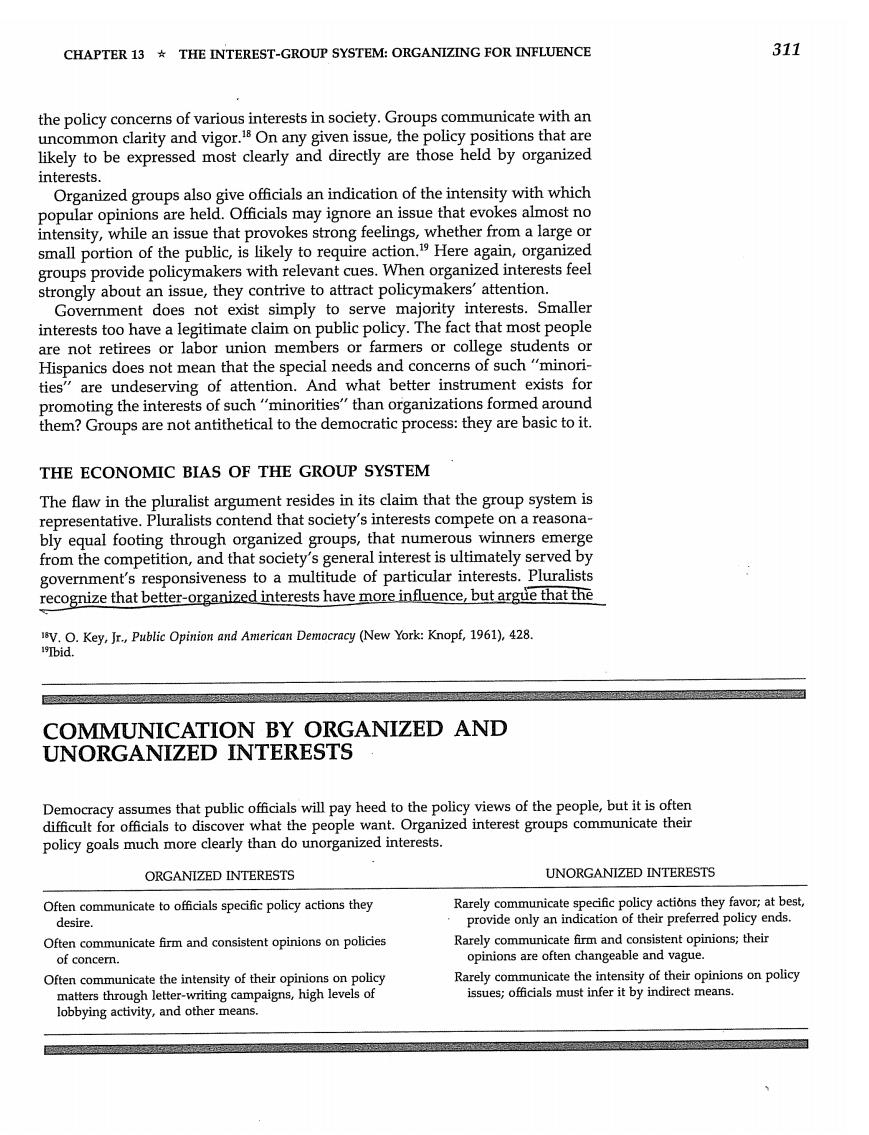
CHAPTER 13 THE INTEREST-GROUP SYSTEM:ORGANIZING FOR INFLUENCE 311 the policy concerns of various interests in society.Groups communicate with an uncommon clarity and vigor.On any given issue,the policy positions that are likely to be expressed most clearly and directly are those held by organized interests Organized groups also give officials an indication of the intensity with which popular opinions are held.Officials may ignore an issue that evokes almost no intensity,while an issue that provokes strong feelings,whether from a large or small portion of the public,is likely to require action.19 Here again,organized groups provide policymakers with relevant cues.When organized interests feel strongly about an issue,they contrive to attract policymakers'attention Government does not exist simply to serve majority interests.Smaller interests too have a legitimate claim on public policy.The fact that most people are not retirees or labor union members or farmers or college students or Hispanics does not mean that the special needs and concerns of such"minori- ties"are undeserving of attention.And what better instrument exists for promoting the interests of such"minorities"than organizations formed around them?Groups are not antithetical to the democratic process:they are basic to it. THE ECONOMIC BIAS OF THE GROUP SYSTEM The flaw in the pluralist argument resides in its claim that the group system is representative.Pluralists contend that society's interests compete on a reasona- bly equal footing through organized groups,that numerous winners emerge from the competition,and that society's general interest is ultimately served by government's responsiveness to a multitude of particular interests.Pluralists recognize that better-organized interests have more influence,but argue that the V.O.Key,Jr.,Public Opinion and American Democracy (New York:Knopf,1961),428. 1Tbid. COMMUNICATION BY ORGANIZED AND UNORGANIZED INTERESTS Democracy assumes that public officials will pay heed to the policy views of the people,but it is often difficult for officials to discover what the people want.Organized interest groups communicate their policy goals much more clearly than do unorganized interests. ORGANIZED INTERESTS UNORGANIZED INTERESTS Often communicate to officials specific policy actions they Rarely communicate specific policy actions they favor;at best, desire. provide only an indication of their preferred policy ends. Often communicate firm and consistent opinions on policies Rarely communicate firm and consistent opinions;their of concern. opinions are often changeable and vague. Often communicate the intensity of their opinions on policy Rarely communicate the intensity of their opinions on policy matters through letter-writing campaigns,high levels of issues;officials must infer it by indirect means. lobbying activity,and other means
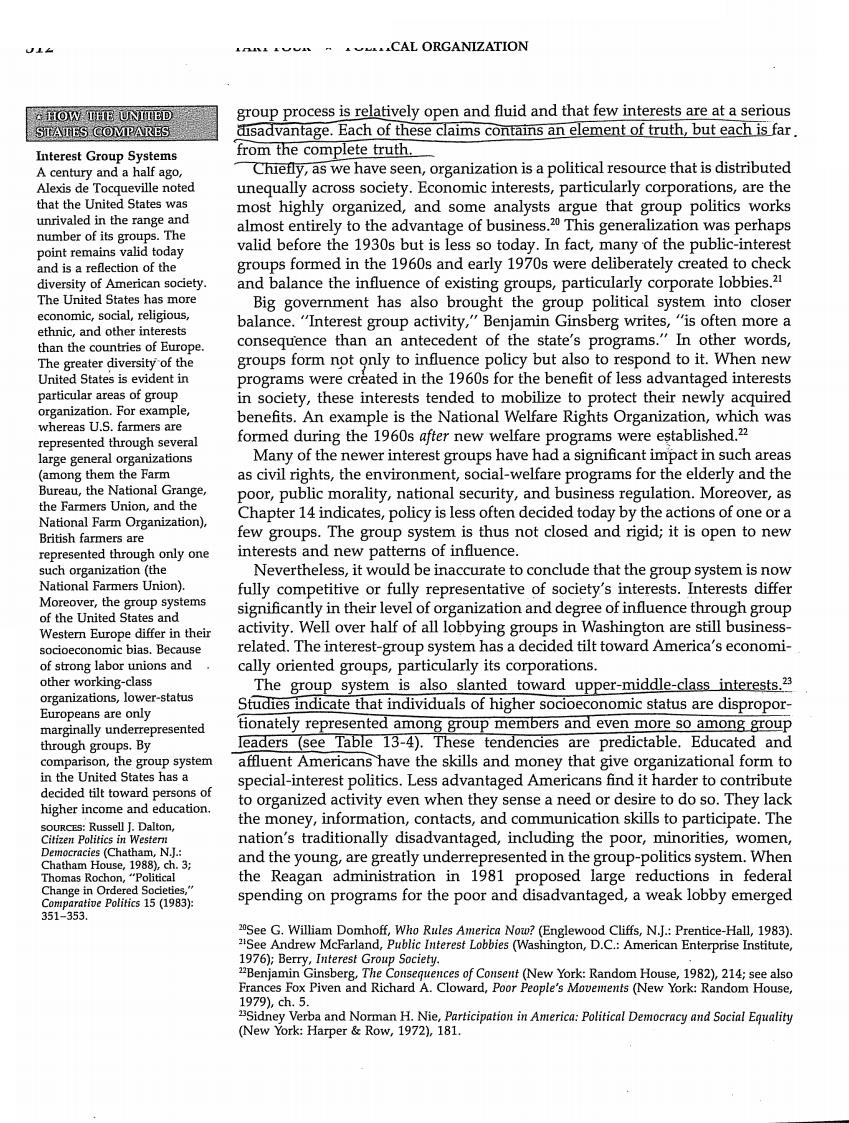
CAL ORGANIZATION HOW THE UNITED group process is relatively open and fluid and that few interests are at a serious STATES COMPARES disadvantage.Each of these claims contains an element of truth,but each is far Interest Group Systems from the complete truth. A century and a half ago, Chiefly,as we have seen,organization is a political resource that is distributed Alexis de Tocqueville noted unequally across society.Economic interests,particularly corporations,are the that the United States was most highly organized,and some analysts argue that group politics works unrivaled in the range and number of its groups.The almost entirely to the advantage of business.2 This generalization was perhaps point remains valid today valid before the 1930s but is less so today.In fact,many of the public-interest and is a reflection of the groups formed in the 1960s and early 1970s were deliberately created to check diversity of American society. and balance the influence of existing groups,particularly corporate lobbies.2 The United States has more Big government has also brought the group political system into closer economic,social,religious, balance."Interest group activity,"Benjamin Ginsberg writes,"is often more a ethnic,and other interests than the countries of Europe. consequence than an antecedent of the state's programs."In other words, The greater diversity of the groups form not only to influence policy but also to respond to it.When new United States is evident in programs were created in the 1960s for the benefit of less advantaged interests particular areas of group in society,these interests tended to mobilize to protect their newly acquired organization.For example, whereas U.S.farmers are benefits.An example is the National Welfare Rights Organization,which was represented through several formed during the 1960s after new welfare programs were established.22 large general organizations Many of the newer interest groups have had a significant impact in such areas (among them the Farm as civil rights,the environment,social-welfare programs for the elderly and the Bureau,the National Grange, poor,public morality,national security,and business regulation.Moreover,as the farmers Union,and the National Farm Organization), Chapter 14 indicates,policy is less often decided today by the actions of one or a British farmers are few groups.The group system is thus not closed and rigid;it is open to new represented through only one interests and new patterns of influence. such organization (the Nevertheless,it would be inaccurate to conclude that the group system is now National Farmers Union). fully competitive or fully representative of society's interests.Interests differ Moreover,the group systems significantly in their level of organization and degree of influence through group of the United States and Western Europe differ in their activity.Well over half of all lobbying groups in Washington are still business- socioeconomic bias.Because related.The interest-group system has a decided tilt toward America's economi- of strong labor unions and cally oriented groups,particularly its corporations. other working-class The group system is also slanted toward upper-middle-class interests.23 organizations,lower-status Studies indicate that individuals of higher socioeconomic status are dispropor- Europeans are only marginally underrepresented tionately represented among group members and even more so among group through groups.By leaders (see Table 13-4).These tendencies are predictable.Educated and comparison,the group system affluent Americans have the skills and money that give organizational form to in the United States has a special-interest politics.Less advantaged Americans find it harder to contribute decided tilt toward persons of higher income and education. to organized activity even when they sense a need or desire to do so.They lack SOURCEs:Russell J.Dalton, the money,information,contacts,and communication skills to participate.The Citizen Politics in Western nation's traditionally disadvantaged,including the poor,minorities,women Democracies (Chatham,N.J.: Chatham House,1988),ch.3; and the young,are greatly underrepresented in the group-politics system.When Thomas Rochon,"Political the Reagan administration in 1981 proposed large reductions in federal Change in Ordered Societies," Comparative Politics 15 (1983): spending on programs for the poor and disadvantaged,a weak lobby emerged 351-353. 2See G.William Domhoff,Who Rules America Now?(Englewood Cliffs,N.J.:Prentice-Hall,1983). aSee Andrew McFarland,Public Interest Lobbies (Washington,D.C.:American Enterprise Institute, 1976);Berry,Interest Group Society. 2Benjamin Ginsberg,The Consequences of Consent(New York:Random House,1982),214;see also Frances Fox Piven and Richard A.Cloward,Poor People's Movements (New York:Random House, 1979),ch.5. Sidney Verba and Norman H.Nie,Participation in America:Political Democracy and Social Equality (New York:Harper Row,1972),181
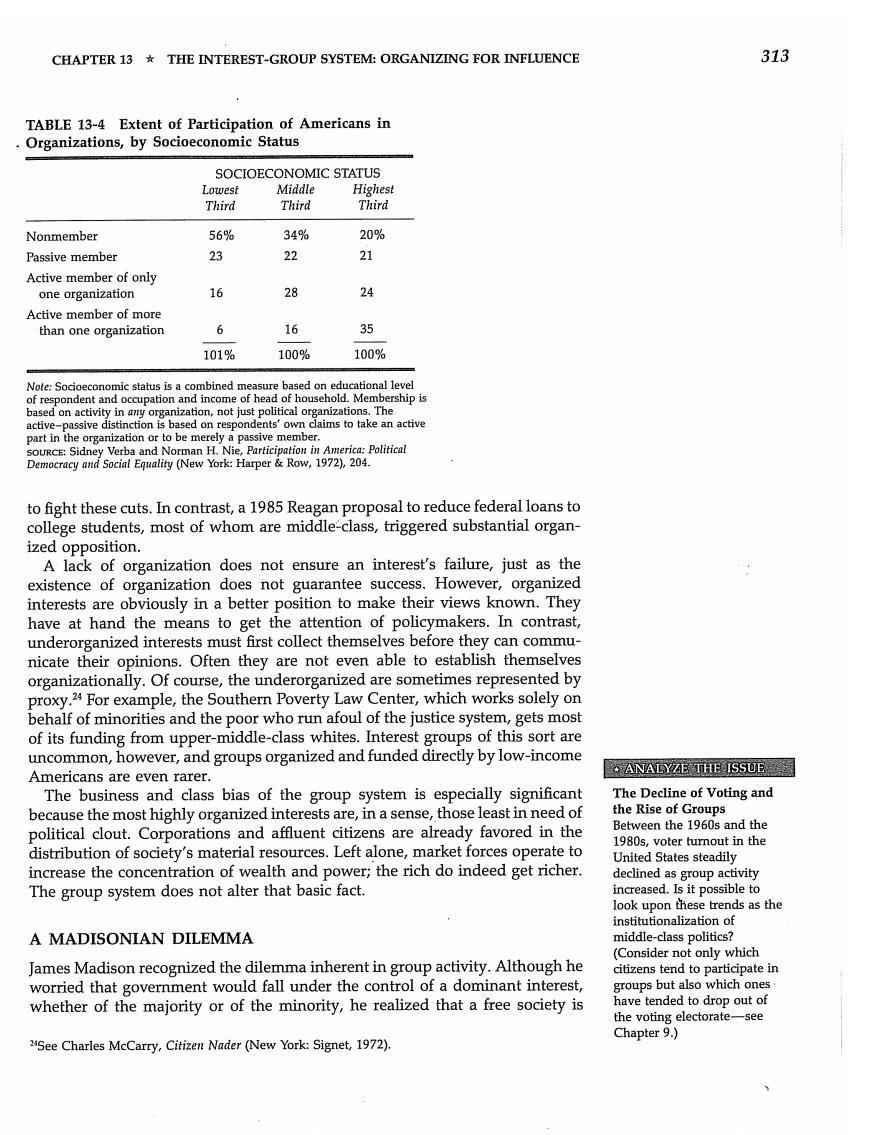
CHAPTER 13 THE INTEREST-GROUP SYSTEM:ORGANIZING FOR INFLUENCE 313 TABLE 13-4 Extent of Participation of Americans in Organizations,by Socioeconomic Status SOCIOECONOMIC STATUS Lowest Middle Highest Third Third Third Nonmember 56% 34% 20% Passive member 23 22 21 Active member of only one organization 16 28 24 Active member of more than one organization 6 16 35 101% 100% 100% Note:Socioeconomic status is a combined measure based on educational level of respondent and occupation and income of head of household.Membership is based on activity in any organization,not just political organizations.The active-passive distinction is based on respondents'own claims to take an active part in the organization or to be merely a passive member. SoURcE:Sidney Verba and Norman H.Nie,Participation in America:Political Democracy and Social Equality (New York:Harper Row,1972),204. to fight these cuts.In contrast,a 1985 Reagan proposal to reduce federal loans to college students,most of whom are middle-class,triggered substantial organ- ized opposition. A lack of organization does not ensure an interest's failure,just as the existence of organization does not guarantee success.However,organized interests are obviously in a better position to make their views known.They have at hand the means to get the attention of policymakers.In contrast, underorganized interests must first collect themselves before they can commu- nicate their opinions.Often they are not even able to establish themselves organizationally.Of course,the underorganized are sometimes represented by proxy.24 For example,the Southern Poverty Law Center,which works solely on behalf of minorities and the poor who run afoul of the justice system,gets most of its funding from upper-middle-class whites.Interest groups of this sort are uncommon,however,and groups organized and funded directly by low-income Americans are even rarer. ·ANALYZE THE ISSUE The business and class bias of the group system is especially significant The Decline of Voting and because the most highly organized interests are,in a sense,those least in need of the Rise of Groups political clout.Corporations and affluent citizens are already favored in the Between the 1960s and the 1980s,voter turnout in the distribution of society's material resources.Left alone,market forces operate to United States steadily increase the concentration of wealth and power;the rich do indeed get richer. declined as group activity The group system does not alter that basic fact. increased.Is it possible to look upon these trends as the institutionalization of A MADISONIAN DILEMMA middle-class politics? (Consider not only which James Madison recognized the dilemma inherent in group activity.Although he citizens tend to participate in worried that government would fall under the control of a dominant interest, groups but also which ones whether of the majority or of the minority,he realized that a free society is have tended to drop out of the voting electorate-see Chapter 9.) RSee Charles McCarry,Citizen Nader (New York:Signet,1972)
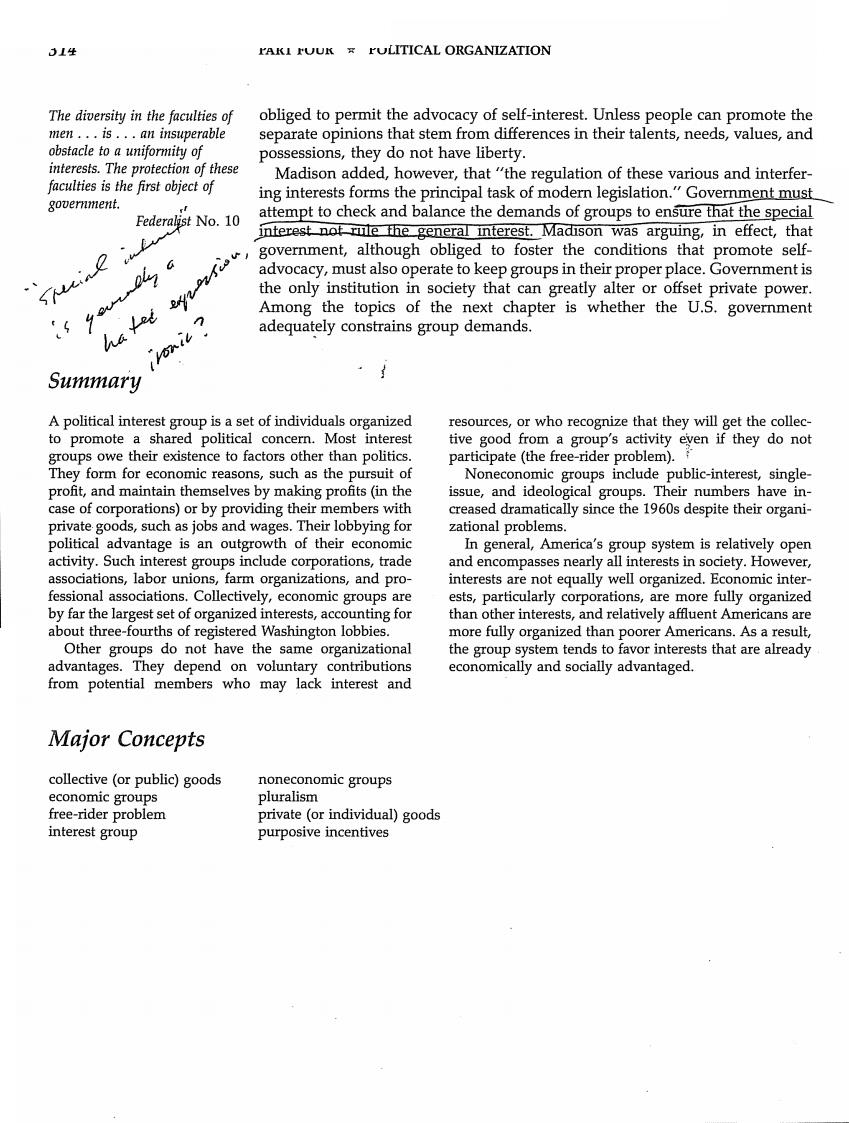
dL生 FAKI FUUK FULITICAL ORGANIZATION The diversity in the faculties of obliged to permit the advocacy of self-interest.Unless people can promote the men...is...an insuperable separate opinions that stem from differences in their talents,needs,values,and obstacle to a uniformity of possessions,they do not have liberty. interests.The protection of these Madison added,however,that "the regulation of these various and interfer- faculties is the first object of ing interests forms the principal task of modern legislation."Government must government. Federalist No.10 attempt to check and balance the demands of groups to ensure that the special interest not rule the general interest.Madison was arguing,in effect,that 0 government,although obliged to foster the conditions that promote self- advocacy,must also operate to keep groups in their proper place.Government is the only institution in society that can greatly alter or offset private power. Among the topics of the next chapter is whether the U.S.government adequately constrains group demands. Summary A political interest group is a set of individuals organized resources,or who recognize that they will get the collec- to promote a shared political concern.Most interest tive good from a group's activity even if they do not groups owe their existence to factors other than politics. participate(the free-rider problem). They form for economic reasons,such as the pursuit of Noneconomic groups include public-interest,single- profit,and maintain themselves by making profits(in the issue,and ideological groups.Their numbers have in- case of corporations)or by providing their members with creased dramatically since the 1960s despite their organi- private goods,such as jobs and wages.Their lobbying for zational problems. political advantage is an outgrowth of their economic In general,America's group system is relatively open activity.Such interest groups include corporations,trade and encompasses nearly all interests in society.However, associations,labor unions,farm organizations,and pro- interests are not equally well organized.Economic inter- fessional associations.Collectively,economic groups are ests,particularly corporations,are more fully organized by far the largest set of organized interests,accounting for than other interests,and relatively affluent Americans are about three-fourths of registered Washington lobbies. more fully organized than poorer Americans.As a result, Other groups do not have the same organizational the group system tends to favor interests that are already advantages.They depend on voluntary contributions economically and socially advantaged. from potential members who may lack interest and Major Concepts collective(or public)goods noneconomic groups economic groups pluralism free-rider problem private(or individual)goods interest group purposive incentives
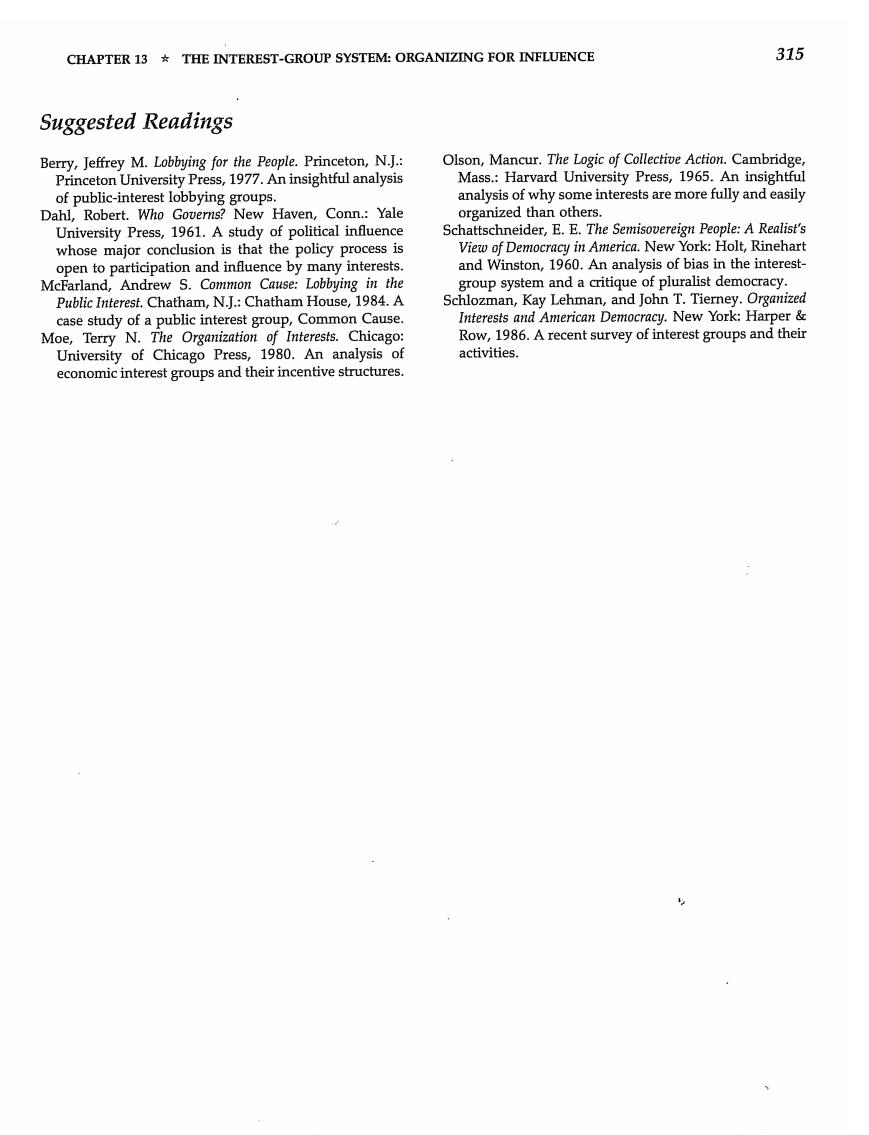
CHAPTER 13 THE INTEREST-GROUP SYSTEM:ORGANIZING FOR INFLUENCE 315 Suggested Readings Berry,Jeffrey M.Lobbying for the People.Princeton,N.J.: Olson,Mancur.The Logic of Collective Action.Cambridge, Princeton University Press,1977.An insightful analysis Mass.:Harvard University Press,1965.An insightful of public-interest lobbying groups. analysis of why some interests are more fully and easily Dahl,Robert.Who Governs?New Haven,Conn.:Yale organized than others. University Press,1961.A study of political influence Schattschneider,E.E.The Semisovereign People:A Realist's whose major conclusion is that the policy process is View of Democracy in America.New York:Holt,Rinehart open to participation and influence by many interests. and Winston,1960.An analysis of bias in the interest- McFarland,Andrew S.Common Cause:Lobbying in the group system and a critique of pluralist democracy. Public Interest.Chatham,N.J.:Chatham House,1984.A Schlozman,Kay Lehman,and John T.Tierney.Organized case study of a public interest group,Common Cause. Interests and American Democracy.New York:Harper Moe,Terry N.The Organization of Interests.Chicago: Row,1986.A recent survey of interest groups and their University of Chicago Press,1980.An analysis of activities. economic interest groups and their incentive structures